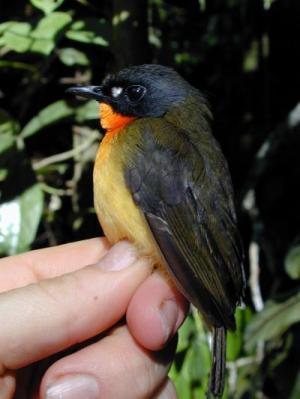New Bird Discovered in Gabon
Posted by: Loren Coleman on August 20th, 2008

A new bird species has been discovered in Gabon, Africa. According to Science Daily, the discoverers are from the Smithsonian Institution. The release says, in part:
The newly found olive-backed forest robin (Stiphrornis pyrrholaemus) was named by the scientists for its distinctive olive back and rump. Adult birds measure 4.5 inches in length and average 18 grams in weight. Males exhibit a fiery orange throat and breast, yellow belly, olive back and black feathers on the head. Females are similar, but less vibrant. Both sexes have a distinctive white dot on their face in front of each eye.
The bird was first observed by Smithsonian scientists in 2001 during a field expedition of the National Zoo’s Monitoring and Assessment of Biodiversity Program in southwest Gabon. It was initially thought, however, to be an immature individual of an already-recognized species. Brian Schmidt, a research ornithologist at the Smithsonian’s National Museum of Natural History and a member of the MAB program’s team, returned to Washington, D.C., from Gabon in 2003 with several specimens to enter into the museum’s bird collection. When he compared them with other forest robins of the genus Stiphrornis in the collection, Schmidt immediately noticed differences in color and plumage, and realized the newly collected birds might be unique.
“I suspected something when I found the first bird in Gabon since it didn’t exactly match any of the species descriptions in the field guides,” Schmidt said. “Once I was able to compare them side by side to other specimens in our collections it was clear that these birds were special. You, of course, have to be cautious, but I was still very excited at the prospect of possibly having found a new species of bird.”
To ensure that the specimens Schmidt collected were a new species, geneticists at the Smithsonian’s National Zoo compared the DNA of the new specimens to that of the four known forest robin species. The results clearly showed that these birds were in fact a separate and distinct species.
Discovering an unknown mammal or bird species is far from a common event. Before the 20th century, the rate of discoveries was great—several hundred new species were being described each decade. Since then, however, the pace has slowed and new species of vertebrates are generally only found in isolated areas.
Now officially recognized, the olive-backed forest robin brings Gabon’s number of known bird species to 753. Other than its existence, however, little is known to science about this newcomer.
***
“Although finding an unknown species like the olive-backed forest robin was not the goal of the MAB project,” Schmidt said, “it is definitely a reminder that the world still holds surprises for us.”
These findings were published in the international science journal Zootaxa, August 15, 2008.
For more background, read the full text at “New Bird Species Discovered In Gabon, Africa” at ScienceDaily, August 16, 2008.
About Loren Coleman
Loren Coleman is one of the world’s leading cryptozoologists, some say “the” leading living cryptozoologist. Certainly, he is acknowledged as the current living American researcher and writer who has most popularized cryptozoology in the late 20th and early 21st centuries.
Starting his fieldwork and investigations in 1960, after traveling and trekking extensively in pursuit of cryptozoological mysteries, Coleman began writing to share his experiences in 1969. An honorary member of Ivan T. Sanderson’s Society for the Investigation of the Unexplained in the 1970s, Coleman has been bestowed with similar honorary memberships of the North Idaho College Cryptozoology Club in 1983, and in subsequent years, that of the British Columbia Scientific Cryptozoology Club, CryptoSafari International, and other international organizations. He was also a Life Member and Benefactor of the International Society of Cryptozoology (now-defunct).
Loren Coleman’s daily blog, as a member of the Cryptomundo Team, served as an ongoing avenue of communication for the ever-growing body of cryptozoo news from 2005 through 2013. He returned as an infrequent contributor beginning Halloween week of 2015.
Coleman is the founder in 2003, and current director of the International Cryptozoology Museum in Portland, Maine.










Cool discovery; it may not be a Sasquatch, but it’s nice to know something new’s still being discovered
Just goes to show that there are many and many animals out there that have not been “discovered” by western science. Though most are small, an intelligent animal may be smart enough to avoid “civilized” humans, even it is big.
Always good news. Pretty bird too. Just want to know how t let the guy hold it. Its hard enough to catch the finches inside the pet store I work at…